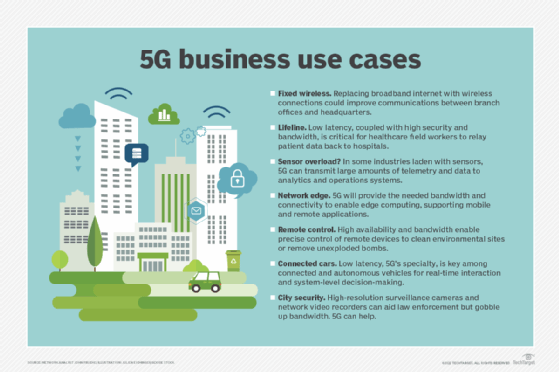7 top 5G enterprise use cases and business opportunities
As 5G cellular networking continues to roll out, some key business use cases have emerged. Fixed wireless access, for example, could improve office connectivity.
Despite some early 5G obstacles, including price premiums, limited access and stalled deployments due to the COVID-19 pandemic, 5G service has now hit the mainstream. All U.S. carriers offer consumer 5G and have removed price premiums. While some 5G network rollouts were delayed, carriers pushed forward because of the boost in consumers working from home.
Smartphones and mobile internet access won't be the only 5G use case. For consumers, the acceptability of 4G LTE performance, data caps and legacy devices could inhibit 5G adoption. But, at the same time, some key 5G benefits could accelerate 5G enterprise use cases.
1. Fixed wireless
One of the top 5G enterprise use cases is fixed wireless -- essentially, replacing broadband internet with a wireless connection. For retail locations, multi-tenancy situations, remote locations and mobile environments, 5G improves connections between branch locations and headquarters. Also, as fixed wireless access rolls out, expect to see significant increases in the use of software-defined WAN (SD-WAN). As more companies have established their work-from-home programs, fixed 5G offers additional bandwidth and better quality of service for enterprise applications that need to cross over to cellular networks.
2. Health sector
The healthcare sector has significant 5G use cases and opportunities. Today, many medical IT groups deal with surgical equipment that needs to be connected and air-gapped from their networks for cybersecurity reasons. Mobile health workers need access in the field during incidents, and critical patient diagnostic data needs to be transmitted between ambulances and emergency rooms. 5G is a great tool for these areas where ultralow latency, security and high bandwidth are all critical. With contact tracing and mapping more common after the COVID-19 pandemic, 5G technology has an opportunity to play a role with mobile contact tracers.
3. Sensor-based systems
Wherever large numbers of sensors, connected devices and IoT devices have been deployed, such as manufacturing, building maintenance, agriculture or transportation, 5G enables massive amounts of telemetry and system information to be sent back to analytics and operations systems. Consider the Target data breach in 2013: The security breach of a third-party HVAC vendor compromised Target's financial data. In a 5G world, vendors can manage the sensor-based systems without relying on the host company's network.

4. Network edge
As network edge computing continues to expand, 5G can provide failover connectivity for SD-WAN and primary connectivity for applications that need to run in remote locations. With 5G's ample bandwidth, computing can happen at the network edge with connectivity back to the headquarters, expanding the network footprint. As SD-WAN and work from home push the network edge in new directions, 5G plays an important role, especially in mobile or remote applications.
5. Remote devices and augmented reality
Precision control of remote devices becomes more of a reality as 5G's 99.999% availability and massive bandwidth better enable remote control of equipment. 5G enables robotic devices to handle dangerous activities, such as environmental cleanup or unexploded ordnance removal, at a distance with more safety and precision. While virtual reality may face bandwidth challenges on a 5G connection, 5G presents a significant opportunity for augmented reality, where smaller data sets and information need to be overlaid on real-time video for repair, servicing or safety applications.
6. The automotive industry
Much has already been said about connected vehicles and their need for 5G based on the huge amount of telemetry they transmit. But, as the world moves closer to semiautonomous and fully autonomous vehicles, low-latency 5G is instrumental as real-time interaction and video are necessary for system-level decision-making. Much of the AI capability for these vehicles needs to be delivered via 5G because the compute happens at the data center, not in the vehicle.
7. Metropolitan areas and smart cities
Today's metropolitan areas are becoming more connected, and 5G use cases help accelerate the idea of smart cities. Residential services, such as streetlights, traffic signals and security, can benefit from 5G. Law enforcement agencies have already deployed 5G-based public safety applications. Surveillance cameras and network video recorders consume significant bandwidth when they support the high resolution needed to identify criminals. Additionally, citywide monitors that triangulate gunshots demand the lowest latency possible -- an area where 5G excels.
Across the board, consumers and businesses can envision 5G use cases. While the consumer benefits are nice to have, the business benefits are far more critical, driving faster 5G adoption on the business side.
Editor's note: This article was updated to reflect changes in the 5G ecosystem.







